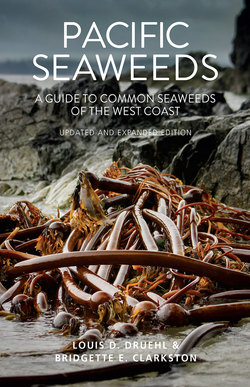Читать книгу Pacific Seaweeds - Louis Druehl - Страница 71
На сайте Литреса книга снята с продажи.
ОглавлениеGreen Seaweeds | 71
Identifying Pacific Seaweeds
Tetraselmis
Class Prasinophyceae Order Chlorodendrales Family Chlorodendraceae
Number of Species
Tetraselmis (Greek=four branches; refers to presence of four flagella, cellu-lar swimming appendages) consists of six species locally, the most common and easily distinguished being T. ascus and T. marina.
Description
Tetraselmis shifts between two unicellular life stages: a swim-ming form and a sedentary form attached to rock by a long clear filament. Both stages are microscopic. In the filamentous stage, Tetraselmis ascus may form colonies of short profuse branches with pigmented cells at the tips, whereas T. marina colonies are typically of long and sparse branches.
Habitat & Distribution
Swimming unicells of Tetraselmis normally inhabit tide pools above the direct influence of the tides. These pools accumu-late salt from ocean spray and are subjected to rain and severe evaporation, resulting in drastic ranges in temperature and salinity—to the point of being a totally dry salt cake! An inhabited pool will resemble pea soup. Tetraselmis is found from BC to central California.
Elliptochloris
Class Trebouxiophyceae Order Prasiolales Family status uncertain
Number of Species
There are six species in the symbiotic green algal genus Elliptochloris, of which only the species E. marina is found as a symbiont within the tissues of sea anemones.
Description
The common Pacific intertidal sea anemones Anthopleura elegantissima and Anthopleura xanthogrammica house microscopic unicellular algae of two types: dinoflagellates and green algae. In this symbiotic relationship, the anemone gains extra nourishment from algal photosynthesis, while the algae gain protection from herbivores and a place to live.
Tetraselmis.
